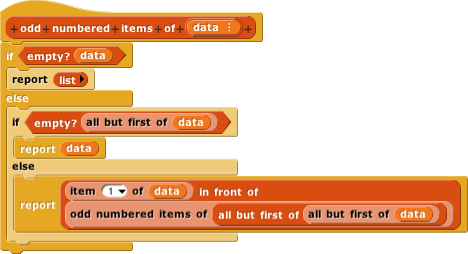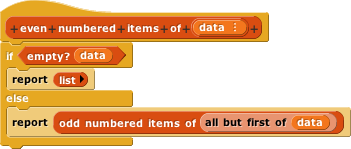
Suppose we have a list of numbers like this:

What we want is a list of the same numbers, in ascending order:

(There's no reason the items have to be numbers, as long as we have some way to order them, like the < operator for numbers. But numbers are easiest to talk about in this context.)
There are many different sorting algorithms. But the best one for recursively generated lists, and probably the most elegant, is called mergesort. Here's the idea in a nutshell: Divide the list in half; recursively sort each half; then merge the two sorted sublists. The base case is that an empty list or a one-item list is already sorted.
The easiest way to divide a list in half turns out to be putting the odd-indexed items (first, third, fifth, etc.) in one half and the even-indexed items (second, fourth, sixth, etc.) in the other.
Note: this will not return the numbers whose values are even/odd, but those whose positions are even/odd.
For example, evens((5, 6, 2, 4, 3, 9)) will report (6, 4, 9) and not (6, 2, 4).


All the work here, basically, is done by the  in
in odd numbered items. This skips the second item and makes the recursive call on items 3 through the end of the list. Note that even numbered items is not directly recursive; it calls odd numbered items, not itself.
Here is a Snap! file OddEven that may be useful in answering these questions.
☞ Why does
odd numbered itemsneed two base cases?☞ Write a version of
even numbered itemsthat calls itself recursively instead of usingodd numbered items.☞ Can you write a version of
odd numbered itemsthat uses (the original)even numbered itemsinstead of calling itself recursively? That structure (A calls B, B calls A) is called mutual recursion.